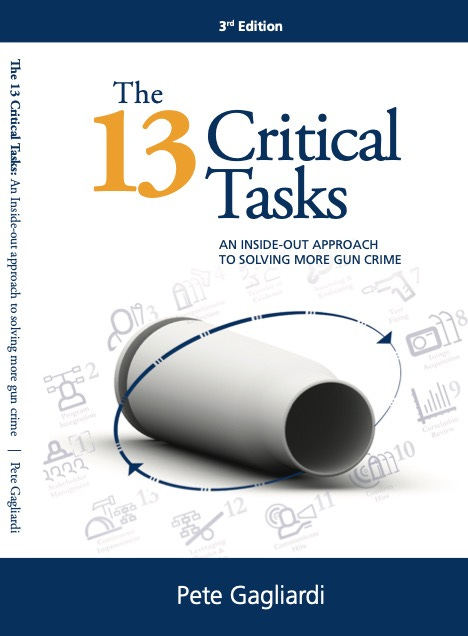The Development of the 13 Critical Tasks
by Pete Gagliardi
Why were they developed?
Forensic Technology, a LeadsOnline company provides solutions that assist law enforcement agencies worldwide to reduce violent crime. As the provider of the IBIS collection of automated ballistic identification solutions since 1991, Forensic Technology and its predecessor companies observed that while some organizations have stood out as highly successful “power users” of its technology solutions, others did not. Determined to understand why, the company found that their “power users” shared many things in common in terms of the critical tasks that they perform and the policies that drive them, to sustain their successes.
How were they developed?
In May 2005, to see as many customers as possible achieve the maximum benefits from their IBIS investment, Forensic Technology began an aggressive project to identify the tasks critical to operating an efficient and effective ballistic information-sharing network. A core working group was formed; it consisted of experienced IBIS power users, two well-known crime researchers from the academic community, and Forensic Technology personnel experienced in forensic ballistics, firearm crime investigation, and IBIS technology.
The core working group contributed best practices by drawing upon their personal experiences with IBIS or reporting on observations they had made during visits to other IBIS power users around the world. The core group also searched for commonalities in the ways in which power users integrated ballistics technology into their crime-solving processes.
Asking the Right Question
All of this information was used to answer one very carefully crafted question: “What critical tasks must be performed to operate an efficient and effective integrated ballistic information network program that provides substantial and sustainable crime-solving benefits to the public?”
A great deal of care went into drafting the question because the quality and accuracy of the answers received depended on the content of the question itself. In more layman’s terms: The questions you ask - determine the answers you get.
The intent was to expand the group’s thinking well beyond the forensic discipline of firearm examination and IBIS technology, the question was revised and tweaked numerous times.
Keywords like: efficient, effective, integrated, program, substantial, sustainable, crime solving, benefits, and public were inserted after much discussion and with deliberate meaning attached.
For example:
· Crime-solving benefits and public: These words identified effective public service as the ultimate objective. With this goal in mind, the core working group looked at improvements in firearm crime-solving from the public’s point of view, instead of that of the police or the forensic labs. The public isn’t interested in agency rivalries, feuds, and excuses like “that’s their job, not ours” or “that’s our job, not theirs”. The public wants law enforcement agencies to use common sense and good judgment. Therefore, during the core working group’s discussions, the interests of the public were always at the forefront and served as the standard to be met. The personnel, processes, and technology employed by the police, the forensic lab, and the prosecuting attorney were certainly a major focus of the core working group’s analysis, albeit from the external and service-oriented perspective when determining how resources could be best used to provide sustainable crime solving benefits to the public.
· Efficient and effective: These words were intended to ensure that, in terms of people, processes, and technology, the invested time and effort were worth the resulting rewards.
· Integrated and program: These words were intended to ensure that informational and institutional bottlenecks that interfere with crime-solving success were eliminated up, down, and across the affected stakeholder organizations and that programs of action would be created so that they would be well defined, adequately funded and measured for efficiency and effectiveness.
· Substantial and sustainable: These words were intended to ensure that the benefits delivered would be considerable, not inconsequential. The levels of people, processes, and technology required for success must be maintained for as long as required. Successful crime reduction programs and processes must be institutionalized and instinctively recognized as the proper way of conducting business.
If you are unconvinced, then try replacing the word “public” with “police”, “Forensic lab” or “prosecuting attorney” at the end of the driving question: “What critical tasks must be performed to operate an efficient and effective integrated ballistic information network program that provides substantial and sustainable crime solving benefits to the public?” -- and see the types of answers that come to mind.
The Results
“The 13 Critical Tasks” were developed through an analysis of what the most successful power users were doing, challenged by the key question that the working group had drafted to ensure the delivery of substantial and sustainable benefits to the public that the affected law enforcement agencies, the crime labs, and District Attorneys had sworn to serve.
The 13 Tasks help form the basis for a complete firearm-related crime-solving program, because perhaps with the exception of the three strictly ballistics-related tasks (i.e., image acquisition, correlation review, and confirming hits/leads) they also relate to the execution of effective Crime Gun Intelligence (CGI) programs.
The book: “The 13 Critical Tasks: An Inside-out Approach to Solving More Gun Crime”, provides the reader with more than just a set of best practices for using ballistics technology. It delves deeply into the tasks that must be addressed when establishing sustainable CGI protocols, and ways in which to balance the people, processes, and technology to do so. Protocols are needed in order to collect and analyze all of the available CGI data that can be obtained from crime guns and related evidence for crime-solving and crime-prevention purposes.
These commonsense steps can help readers identify and establish a series of consistently applied protocols to ensure that all of the valuable information from inside and outside a crime gun and other available bits and pieces of CGI are exploited by police and forensic agencies in a given region to help generate leads to stop armed criminals before they can do more harm.
The Most Important Thing
Follow these 13 Critical Tasks developed by law enforcement and forensic practitioners in consultation with renowned academic researchers, to integrate tactics and strategies that can provide substantial and sustainable firearm crime-solving benefits to the public, or follow your own developed similarly.
Endnote:
The QR Code below will take you to an electronic copy of the book, The 13 Critical Tasks: An Inside-out Approach to Solving More Gun Crime, compliments of LeadsOnline, that you can download from here:








